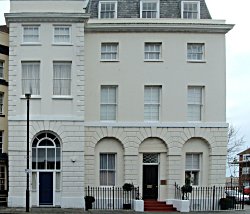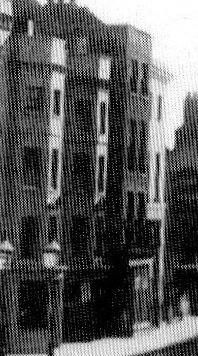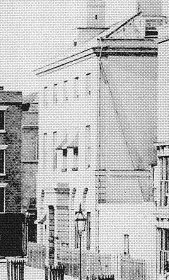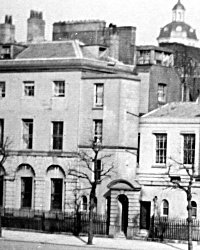
Nos. 59-60 High Street

These two buildings are grouped together because they are the last two buildings before the project reaches Grand Parade.
In comparing the Charpentier drawing to the 2009 photograph (below), it is immediately obvious that the former distorts the width of the buildings quite considerably. The widths suggested by Charpentier are 20' and 27.5', whereas on the ground they are 15'1" and 33'0". The Charpentier is so inaccurate that it cannot be a simple slip of the pen. Perhaps the owners of No. 60 had declined to subscribe to the drawing, whereas those at No. 59 had paid up and this was the publishers revenge.

There is an interesting way in which the front of No. 59 was remodelled after 1842 in such a way as to exaggerate the importance of the building. This was achieved by introducing an arched doorway, surrounded by sophisticated stonework, of such height that it equals the height of the stonework to No. 60. In doing so, the original balcony and both first floor windows have been sacrificed, creating in effect a two floor atrium. The extraordinary boldness of this new design certainly elevated the standing of No. 59 though it could hardly compensate for the the fact that it was only half the width of it's neighbour. As we shall see shortly this change probably occurred sometime around the turn of the 19/20C.

We can be confident that the upgrading of No. 59 took place well after our target date because there is a photograph of the Soldiers Institute taken from the north in the late 1870s and it shows No. 59 in the background (see right) and in this we can see that the balcony still exists.
The 1842 drawing shows the ground floor of No. 59 to have an entrance doorway flanked on both sides by shop windows which cannot have been much wider than about 6 feet, given the narrowness of the building.
The High Street frontage to No. 60 seems to be unaltered from the date of the Charpentier drawing but there is room for debate about the nature of the roof structure. One early 19C drawing (below) shows there to be dormers on both the High Street and Grand Parade sides but does not show the roof. Later images show a very low gabled roof, which may explain why it didn't appear in the earlier drawing, whilst the modern steep sided roof structure only appears at some stage after World War 2. Google Earth shows a largely flat roof to No. 59 which may confirm the impression given by the Charpentier drawing. Equally, the drawing may have omitted the roof structure and the flat roof may be a modern development, though anecdotal evidence suggests it was flat from at least 1930.

The Grand Parade facade of No. 60 was modified on a couple of occasions. Early drawings, including Charpentier, show that there was a doorway instead of the central ground floor window. To this was added an elegant portico, probably in the mid 1860s; it was certainly there in the mid 1870s as can be seen on the photo detail below. The photograph is not dated but the full version shows a memorial to the 8th King's Regiment which was in place between 1863 and 1877. At a later date still the portico was removed and the doorway blocked up.
Another modification concerned what appears to have been an extension to the rear of No. 60. The early 19C drawing shows a structure of two-thirds the height of the main building but with windows in the top floor only. As the lower section was plainly not for dwelling perhaps it was a stable. Much later images depict a four story addition but there was a period between the two where there seems to have been no building there at all.
DOCUMENTARY EVIDENCE

Kelly's (1859) Directory - Thomas Hammond Fiske, Bookseller and Stationer, 59 High Street; British Industry Fire and Life Office, TH Fiske, 59 High Street; Unity Fire and Life Office, TH Fiske, 59 High Street; Grant Gilman & Long 60 High Street.
Post Office (1859) Directory - Thomas Hammond Fiske, Print and Music Seller & Fancy Stationer, 59 High Street; Grants, Gillman and Long, 60 High Street, draw on Glyn & Co., London
Simpson's (1863) Directory - Fisk, Thomas, stationer, 59, High St.; Grant Gillman & Long, Portsmouth Bank, 59 (sic) High St. and at Queen St.
Harrod's (1865) Directory - County Magistrate, William Grant, Grand Parade; Grants, Gillman & Long, 60 High Street, draws on Glyn, Mills & Co., London
The 1861 Census
Schedule 44 - Thomas H. Fiske (73, Music Seller and Stationer), his sister Mary Ann (78), his assistant Fanny Bailey (22), and house servants Emily Taylor (20) and Sarah Nock (18).
Schedule 45 - William Grant (61, Banker), his wife Mary (59), son William (22, Banker), daughter Emily (19), with visitors, Francis Eastment (30, Landed Proprietor), wife Kate (20) and daughter Kate (1) and servants Eliza Trapnell (37), Louisa Glendenning (33), Henry Draper (22) and Maria Brown (40).
Thomas Fiske seems to have been an energetic sort of fellow given the various trades he followed, though he may have been somewhat quixotic given that Charpentier showed his trade to have been silversmith and jeweller. It must have been some significant event that reduced his trade from such a high point to that of stationer within 20 years. Maybe he just aged and took a less strenuous job as at the 1861 census he was recorded as being 73 years of age, which does suggest he was the same Fiske that Charpentier recorded in 1842. He doesn't appear in the 1865 directory so it seems likely that he had finally retired, though he may not have sold the property as no one else was advertised as working from that address.
Grant, Gillman & Long's bank later became Grant & Madison's Union Banking Co. which in turn was absorbed by Lloyds Bank. [See our article on Banking in Old Portsmouth.] By 1913 Lloyd's Bank had expanded and bought No. 59; it may have been at this stage that the remodelling of the facade occurred.
There is little that can be gleaned from the entries under William Grant's name to explain the usage of the detached building at the rear of No. 60 High Street, unless it was servants quarters. No. 60 is a very big house itself, more than large enough to accommodate all those listed in the census. There is further evidence in this matter on the page discussing the north side of Grand Parade.
SUMMARY
The model of the front of both buildings will replicate the frontages shown in the Charpentier drawing, albeit at a more realistic scale, given that the evidence shows that No. 59 was re-structured well after 1860. The roof to No. 60 can be fairly clearly defined and doesn't seem to have been modified before the 20th century. We can only guess at the roof for No. 59 and in the absence of definite information it will be left flat with a high parapet. The entrance on the Grand Parade side of No. 60 will be included in the model and even though we have no knowledge of the date the portico was added, that will be shown as well.

There is one factor that these buildings share. In both cases the rear of the building could be seen from Grand Parade though No. 59 is partially obscured by No. 60 (see photo, right). Modelling this side of these buildings will be difficult given that there are no relevant images before about 1900 and this is compounded by changes that certainly happened to the structures between 1842 and that date. We know that the front facade to No. 59 was drastically remodelled and it's possible that this had an effect on the rear of the building; also, what appears to be an extension tacked on to the rear of No. 60 has definitely changed though the early 19C drawing mentioned earlier indicates that it was possibly in existence right through our target period. The photo from the 1870s above indicates that the extension was not there at that time and this fact will be reflected in the model.